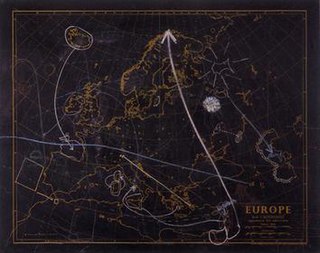George Brecht
[3][4][5] He described his own art as a way of "ensuring that the details of everyday life, the random constellations of objects that surround us, stop going unnoticed.
He enlisted for military service in 1943, and it was whilst he was stationed near the Black Forest, Germany, 1945, that he changed his surname to 'Brecht' – 'not in reference to Bertolt Brecht, but because he liked the sound of the name'.
[6] After World War II, he studied chemistry at the Philadelphia College of Pharmacy & Science, finishing his degree and marrying his first wife Marceline in 1951.
[12] The meetings also led to both Brecht and Kaprow attending John Cage's class at The New School for Social Research, New York, often driving down together from New Brunswick.
"[17] prompting Brecht to pare the scores down to haiku-like statements, leaving space for radically different interpretations each time the piece was performed.
Later in his life, when asked about his father, Brecht replied that "[he] gave up music-making in the mid-'30s by lying down and not breathing any more on the couch at 165 W. 82nd Street, where we were living at the time.
[22]" This method of distribution – soon to become known as mail art – would become the basis for the buildup to the Yam Festival (May backwards), mid 1962 – May 1963, organized with Robert Watts.
The mailed scores were intended to build anticipation for a monthlong series of events held in New York and on George Segal's farm, New Jersey.
Featuring a large cross section of avant-garde artists, the festival was based around the idea of operating 'as an alternative to the gallery system, producing art that could not be bought'.
[23] Artists participating in the festival included Alison Knowles, Allan Kaprow, John Cage, Al Hansen, Ay-O, Dick Higgins, Karlheinz Stockhausen and Ray Johnson.
Young, a musician who had arrived in New York September 1960,[24] had been asked to guest edit a special edition of Beatitude East on avant-garde art, which evolved into the seminal compendium, An Anthology Of Chance (see [3]) Brecht was the first artist listed in the compendium; the graphic designer and publisher of the book was George Maciunas, who had been attending the same music classes, although by now they were being given by Richard Maxfield.
Instead, these artists found themselves "preferring streets, homes, and railway stations...." Maciunas recognized a radical political potential in all this forthrightly anti-institutional production, which was an important source for his own deep commitment to it.
[31] Whilst the pieces he made for the Fluxus cooperative remain his most famous works, he continued to exhibit artworks within more traditional gallery spaces throughout the 1960s and 1970s.
Brecht started a series called The Book of the Tumbler on Fire in 1964, and exhibited the first 56 at the Fischback Gallery NY in early 1965, shortly before leaving the US.
The pieces consisted of framed collages, made of cotton-filled specimen boxes, designed to show "the continuity of unlike things.
Maciunas' decision to picket a Stockhausen concert of Originale in August 1964 is often seen as the point at which the original, 'heroic' era of Fluxus splintered;[34] the move seems to have alienated Brecht [35] who, whilst not severing relations, left New York in the spring of 1965 for Europe, despite Cage allegedly spending a whole evening trying to persuade him to stay.
[36] He arrived in Rome, April 1965; from there he moved to Villefranche-sur-Mer, France, to start a shop, La Cédille qui Sourit, (The Cedilla That Smiles), with the French artist Robert Filliou, another member of Fluxus.
[37] The shop was intended to explore ideas about the 'obtuse relationship(s) to the institution of language'[38] but instead ushered in what he described cheerfully as "accelerated creative inactivity".
[3] After the shop closed in 1968, Brecht moved to London, where he formed a new company, 'Brecht and MacDiarmid', which proposed a number of Land Mass Translocations.
"One of us (GB) proposed in 1966 that the Arctic ice pack be interchanged with the Antarctic, and in the winter of 1967–8, in London, the idea of moving England closer to the equator presented itself.
This intuition was reinforced by recent scientific studies which have shown that England is being tilted... at a rate such that areas of London 15 meters above sea level or less will be submerged in 1500 years time.
In this light, Brecht and MacDiarmid are undertaking research into the feasibility of moving land masses over the surface of the earth..... Movement of the Isle of Wight would be a pilot project for the larger translocation of England."
[39]In November 1969, Cornelius Cardew's Scratch Orchestra (see [4]) performed Realization of the Journey of the Isle of Wight Westwards by Iceberg to Tokyo Bay, a piece based on Brecht's Translocations, in London.
As part of his lifelong interest in Zen Buddhism, Brecht began a focused study of the Chinese language with the aim of translating the ancient text the Hsin-Hsin-Ming by Seng Ts'an, c600 AD, in 1976.
The excerpts consist in an eccentric collection of articles (many of them found in French flea markets) which materialize details of the narrations and which present a kind of antidote against passive experience – in this case, the mechanical absorption of cheap literature.


